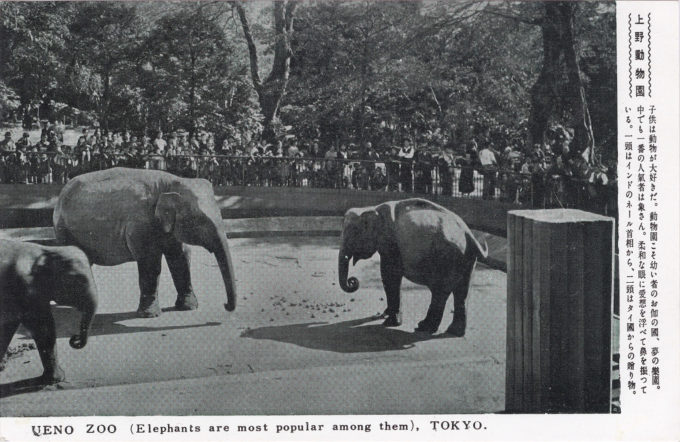
Elephants at Ueno Zoo, Tokyo, c. 1950. The caption reads: “Children love animals. Somersault Garden is a fairyland and a dream park for young children. The elephant is the most popular among them. The elephants are waving their heads in the air with a smile in their soft eyes. One of the elephants was a gift from Prime Minister Nehru of India, and the other two were a gift from Thailand.”
The two youngest elephants had arrived from Thailand on September 4, 1949. Nehru’s gift elephant from India arrived at Ueno Zoo on September 25, welcomed by 2,000 people. The next day, the zoo was filled to capacity with more than 10,000 people hoping to see the new elephants. The three gift elephants replaced three popular pachyderm that were starved to death, along with dozens of other zoo carnivores and herbivores put to death, in August-September 1943 out of great concerns for public safety should they escape the zoo during a bombing. News of the animals’ demise was kept secret from the public until after the end of the Pacific War.
See also:
Ueno Zoological Garden, Ueno Park
“Zoo animals, too, suffered in the war. The fate of the elephants at Ueno is especially well known: they were killed by grieving attendants – so the story goes – to prevent a stampede in the event of bombing … Indira was presented by Prime Minister Jawaharlal Nehru of India in response to a request from war-saddened schoolchildren in Tokyo. Indira, of course, was named after his daughter, Indira Gandhi.
“The images of Indira’s arrival in 1949 are stunning. She walked from the port of disembarkation to the zoo, where she immediately became queen of the realm … greeted by cheering, flag-waving crowds. One of her attendants recalls how unhappy she was, at least initially, with the commotion. She refused to step out of the freight car. And elephants, when upset, apparently develop diarrhea. She soiled the attendant’s fanciest uniform before the festivities had even gotten underway.
“All over Japan, in the days when people were still hungry, they brought offerings – typically sweet potatoes – for Indira. Her attendants enjoyed what she could not eat. No media star could have competed with Indira, except perhaps the newly democratized emperor, surveying the devastated land and inspiring the exhausted people. Indeed, with the flags and the throngs, Indira’s procession properly recalls an imperial progress.
“Is it testimony to the power of modernity that people think to wave national flags at an elephant … [w]as it only children who were more cheered by Indira the Elephant than Hirohito the human emperor?”
– From My Grandmother’s Bedside, by Norma Field, 1997


Pingback: Ueno Zoological Garden, Ueno Park | Old TokyoOld Tokyo